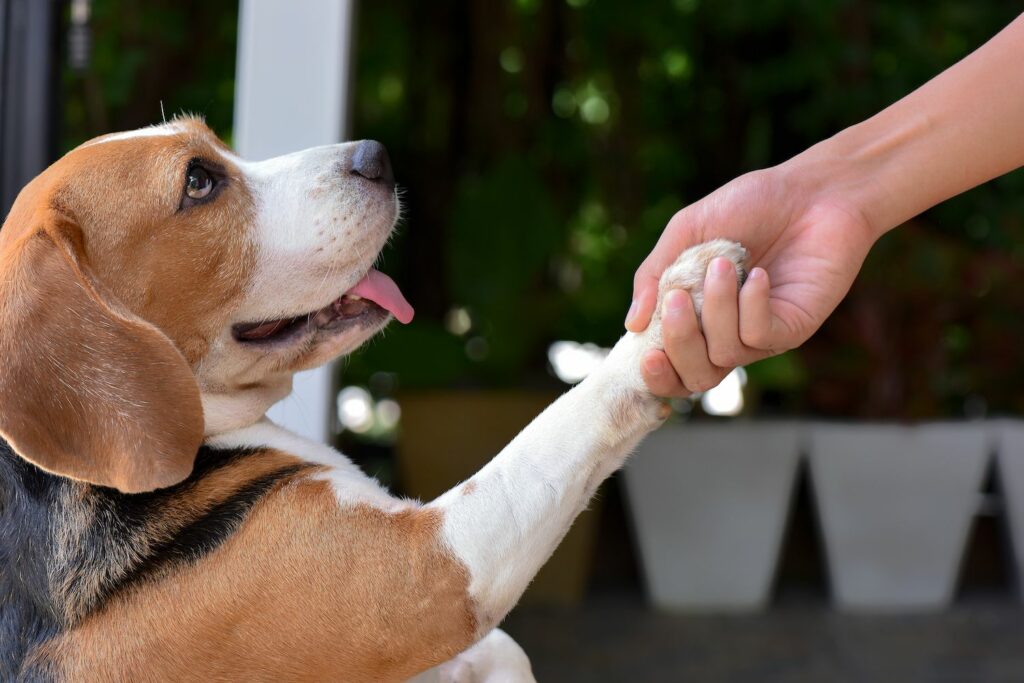Table of Contents
Positive reinforcement training is a humane and effective method to teach your dog good behavior. By rewarding desired actions, you create a positive association that encourages your dog to repeat those behaviors. This guide covers the essentials of positive reinforcement training for dogs, providing tips to help you raise a well-behaved and happy companion.

1. Understand the Basics: Positive Reinforcement Training for Dogs
Positive reinforcement involves rewarding your dog immediately after they perform the desired behavior. Rewards can include treats, praise, toys, or playtime. The key is to make sure the reward is something your dog finds highly motivating.
- Tip: Use high-value treats that your dog loves, especially when teaching new behaviors. For more information, visit ASPCA.
2. Timing is Crucial
Reward your dog immediately after they perform the desired behavior to help them make the connection between the action and the reward. Delayed rewards can confuse your dog and reduce the effectiveness of the training.
- Tip: Use a marker, like a clicker or a specific word (e.g., “yes”), to indicate the exact moment your dog does the right thing. For more details, check out Clicker Training.
3. Be Consistent: Positive Reinforcement Training for Dogs
Consistency is key in positive reinforcement training. Use the same commands and rewards every time your dog performs the desired behavior. This helps your dog understand what is expected of them and reinforces learning.
- Tip: Ensure all family members use the same commands and rewards to avoid confusing your dog. For more tips, visit The Humane Society.
4. Start with Basic Commands
Begin training with basic commands such as “sit,” “stay,” “come,” and “down.” These commands form the foundation for more advanced training and help establish good communication between you and your dog.
- Tip: Keep training sessions short, around 5-10 minutes, to maintain your dog’s focus and interest. For more guidance, visit AKC.
5. Use a Variety of Rewards: Positive Reinforcement Training for Dogs
Mix up the types of rewards you use to keep your dog engaged and motivated. While treats are a popular choice, incorporating praise, toys, and playtime can also be highly effective.
- Tip: Tailor rewards to your dog’s preferences. Some dogs may be more motivated by playtime or a favorite toy than by treats. For more ideas, check out PetMD.
6. Gradually Reduce Treats
As your dog becomes more proficient with a behavior, gradually reduce the frequency of treats. Continue to reward with praise, toys, or playtime to maintain motivation without relying solely on treats.
- Tip: Use a variable reward schedule to keep your dog guessing and motivated. For more advice, visit Cornell Feline Health Center.
7. Avoid Punishment: Positive Reinforcement Training for Dogs
Punishment can create fear and anxiety, which can hinder learning and damage your relationship with your dog. Focus on reinforcing positive behaviors and redirecting unwanted behaviors instead.
- Tip: If your dog exhibits undesirable behavior, redirect their attention to a positive behavior and reward them for it. Learn more about the negative effects of punishment at PAWS.
8. Be Patient and Persistent
Training takes time and patience. Dogs learn at different rates, and some behaviors may take longer to master. Stay patient and persistent, celebrating small successes along the way.
- Tip: Break down complex behaviors into smaller, manageable steps to make training more effective. For more tips, visit Cesar’s Way.
9. Incorporate Training into Daily Routine: Positive Reinforcement Training for Dogs
Integrate training into your daily routine to reinforce good behavior consistently. Practice commands during walks, playtime, and feeding to help your dog understand that good behavior is always rewarded.
- Tip: Use everyday situations as training opportunities to keep sessions natural and less formal. For more ideas, visit VCA Hospitals.
10. Seek Professional Help if Needed
If you’re struggling with training or facing specific behavioral issues, consider seeking help from a professional dog trainer. A certified trainer can provide personalized guidance and support to address your dog’s unique needs.
- Tip: Look for trainers who use positive reinforcement methods and have certifications from reputable organizations like the Association of Professional Dog Trainers (APDT).
Conclusion: Positive Reinforcement Training for Dogs
Positive reinforcement training is an effective and humane way to teach your dog good behavior. By following these tips for positive reinforcement training for dogs, you can build a strong bond with your pet and ensure they grow into a well-behaved companion. Consistency, patience, and the right rewards are key to successful training. For more tips on dog training and care, visit our website.
Frequently Asked Questions about Positive Reinforcement Training for Dogs
What is positive reinforcement training?
Positive reinforcement training involves rewarding your dog for desired behaviors to encourage them to repeat those behaviors. Rewards can include treats, praise, toys, or playtime. For more details, visit ASPCA.
Why is positive reinforcement effective?
Positive reinforcement is effective because it creates a positive association with the desired behavior, making your dog more likely to repeat it. This method is humane and helps build a strong bond between you and your dog.
How long does it take to train a dog using positive reinforcement?
The time it takes to train a dog varies depending on the dog and the behavior being taught. Consistency and patience are key. Some dogs may learn quickly, while others may take longer to master certain behaviors.
Can I use positive reinforcement for all types of dog training?
Yes, positive reinforcement can be used for all types of dog training, from basic commands to complex behaviors. This method is versatile and effective for a wide range of training needs.
What should I do if my dog doesn’t respond to positive reinforcement?
If your dog doesn’t respond to positive reinforcement, try different types of rewards to see what motivates them. You can also seek help from a professional trainer for personalized guidance. For more tips, visit PetMD.











